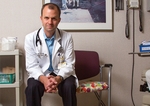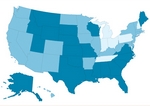Profession
"July phenomenon" from new residents debunked
■ Despite the month's traditional influx of new residents, guidance and protocols given to new physicians provide year-round safety, a growing body of evidence finds.
- WITH THIS STORY:
- » External links
Are patients who have surgery at teaching hospitals during July at greater risk of harm? New residents begin seeing patients then, leaving some patients a little apprehensive about being in inexperienced hands.
But contrary to inpatient lore, the arrival of a new set of freshly minted physicians does not result in more patient deaths or in longer recovery times, a new study says. The "July phenomenon" may be entrenched in the public psyche, but it is a myth, says a study in the September Journal of the American College of Surgeons.
"The 'July Phenomenon': Is Trauma the Exception?" shows there are no differences for in-hospital mortality rates, number of days patients spent in intensive care units or on ventilator support, or minutes spent undergoing resuscitation for trauma patients treated in July compared with other months.
Researchers analyzed data on 12,525 patients who were seen over five years at the University of Tennessee Health Science Center in Memphis. They did not detect any month-by-month differences in outcomes.
"The results of our study add to a growing body of evidence suggesting that the July phenomenon does not exist in major trauma centers with appropriate guidance and supervision of residents," said Peter E. Fischer, MD, a general surgery resident at the hospital and one of the paper's authors.
During the study's timeframe, residents completed one-month rotations at the trauma center. Only patients who were admitted and discharged during the same month were included in the analysis.
Other studies have concluded that July is as safe a month as any to have surgery. For example, a 2003 study in the Journal of Neurosurgery Pediatrics analyzed 4,323 tumor operations that took place between 1998 and 2000 in hospitals nationwide. Researchers found no significant increases in adverse events.
"The next step is to get the word out to the public," Dr. Fischer said. "I still talk to friends who say, 'Oh, man, it's July. I don't want to go near a hospital because the new residents are coming in.' "
Dispelling a myth
The story isn't the same globally, where new doctors arrive at different times of the year. A study from Australia, published online Oct. 13 by the BMJ, found that an influx of new physicians at a Melbourne hospital did result in an increase in adverse events. The study of nearly 20,000 patients who had a medical procedure requiring anesthesia at the large teaching hospital found that the rate of adverse events was higher among "trainees" at the start of their academic years.
Researchers concluded that mentorship with more experienced physicians, as well as closer supervision and graduated clinical responsibilities, should be instituted.
A study from England, published Sept. 23 in the journal PloS One, found a higher death rate among patients admitted shortly after the arrival of "junior doctors" at hospitals.
In the U.S., changes in training and supervision have been implemented to dispel any July phenomenon, said Joanne Conroy, MD, chief health care officer at the Assn. of American Medical Colleges. For example, residents prepare for about a week before they see patients, she said.
"The Accreditation Council for Graduate Medical Education and the teaching hospitals have put a number of processes in place to make sure that when medical students and residents hit the wards, they are far better prepared and far better supervised than they were in the past," Dr. Conroy said.
Even with such changes, erasing the myth of the July phenomenon may take years, she said. "It's easier to establish a myth than to get rid of one."












